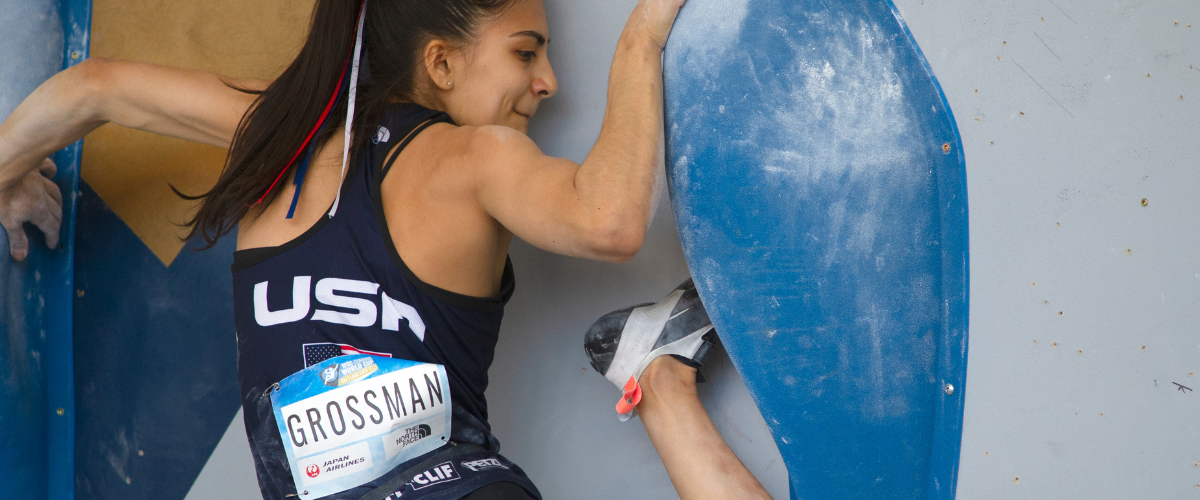Perspectives on Comp Style Routesetting in Indoor Climbing Gyms
oftenfocusedon
A rose by any other name, the landscape of indoor rock climbing has been forever changed by competitive rock climbing. As the sport of rock climbing becomes more popular with the general public, indoor climbing gyms are noticing an ever-increasing divide between regular indoor rock climbing and competition-style climbing.
Article At A Glance |
|
Rock climbing purists argue that competition-style rock climbing isn’t “real” rock climbing at all. They liken the style as being closer to parkour and gymnastics than actual rock climbing. And I mean, they aren’t wrong. Sure, you can find dynamic moves outdoors
But, the type of movement and risk involved in comp-style sequences isn’t something we typically see in nature.
The Evolution of Holds
In the early days of indoor rock climbing, hold companies often focused on developing rock climbing holds that mimicked the type of rock and holds found in nature.
Routesetters would then utilize these holds to develop routes that mimicked sequences found outside, on real rock. They would grade indoor routes based on the common outdoor grading scales. This was how things were done for decades.
Competitive climbing revolutionized the hold manufacturing industry. As the popularity and the landscape of competitive climbing grew, so did the demand for more unique and challenging hold sets.
The development of these new holds also brought innovation to the materials used.
In the 1990s, hold manufacturers started to experiment with plastics. Today, polyester resin and polyurethane are the most common materials used in the manufacturing of plastic climbing holds (although, wood still plays a large part in volume manufacturing).
READ ALSO: The Different Ways to Color-Code Your Setting
And now, the most modern of modern holds (especially those found in competitive climbing) are made of fiberglass.
I love shiny new holds as much as the next climber, but from a business standpoint – keeping up with the Joneses can be daunting, overwhelming, and just plain unrealistic.
As a gym manager, I get sticker shock each time I see the cost of a single fiberglass hold. Hold budgets vary from gym to gym, so I cannot speak for the industry.
But, it is important to note that state-of-the-art, competition-style holds are expensive. Hold cost is a huge factor (and probably a deterrent) for a lot of gyms when determining whether to invest in and set comp-style routes.
The Evolution of Climbing Grades
Traditionally speaking, most indoor climbing routes and problems in North America are set using the Yosemite Decimal System (YDS) and the Vermin scale (V-scale). These scales were developed in the 1930’s and 1990’s, respectively, to grade the difficulty of outdoor routes.
Editor's Note: This Mountain Project Comparison Chart is a great place to start with comparisons of setting scales.
View it here.
Because indoor climbing has evolved so far beyond the common outdoor rock climbing scales and routesetters needed more nuanced ways to discuss routes, a different scale was developed to help understand the difficulty of a particular climb.
Enter the RIC Scale–yet another arbitrary and extremely subjective system for grading the difficulty of climbing.
At its most basic level, the RIC scale is simply an acronym for Risk, Intensity, and Complexity–three separate criteria by which a problem or route should be graded. Each criterion is scored on a scale from 1-5, and then you take the average of the three values for the “overall” grade. For example, a boulder problem might have a risk of 4, intensity of 4, and complexity of 1. The overall grade would be a 3, in this wildly hypothetical situation.
I am not a routesetter, and this article is not targeted toward routsetters. That being said, the RIC scale is its own entirely different beast. Translating the RIC scale into to YDS and V-Scale can be very tricky.
From the gym management perspective, you want routes and boulder problems to have grades on them–because these numbers aid in risk management.
A grade of V0 signals to new climbers that this is (hopefully) an accessible problem. A grade of V8 serves as a warning to new and experienced climbers–this problem is going to be stupid hard, if not impossible. Grades inform climbers on what to expect before they leave the ground.
All I ask for, from a gym management perspective, is that we set our customers up for success. I’m talking about proper education and proper grading of comp problems–consistent with the rest of our gym.
The last thing any of us wants is a first-time climber, in rental shoes, attempting a high-risk comp-style boulder problem with little to no knowledge of the specific movement required to safely complete the moves, and getting injured. Comp boulders look cool, people look cool while doing them, and they make for great Instagram and TikTok content. But, I cringe every time I see rental shoes on a comp boulder.
The Routesetter’s Perspective
As if routesetting wasn’t already a delicate balancing act, modern-day routesetters are now expected to have two opposite and opposing skill sets (a little climber humor for y’all).
Nowadays, routesetters need to know about building outdoor training-focused/real rock climbing-style routes (that mimic the routes found in nature) as well as designing competitive-style routes. Oh shoot, did I say knowledge? I meant they need the knowledge, strength, technique, and other physical skills that we require of our routesetters.
I mean, if they can’t forerun a route or problem–how do we know it goes?
We ask so much out of our routesetters. They put their bodies through the ringer, for us–and most importantly, for the customer. Gym managers and department heads pull our routesetters in so many directions. Youth programs need moderate routes, with jugs and reachable holds for the kiddos.
Give Us Feedback on the CWA's Content
We're constantly trying to build out more content that you find useful. Tell us how we're doing and how to improve in this anonymous 2-minute survey.
Team coaches are on the opposite side of the spectrum. Seasoned outdoor climbers have entirely different needs. And the membership has its spectrum of demands. Set more moderates! Set more comp-style routes! Can you set a 5.13? Set more 5.8s! The gym feels stiff. The gym feels soft.
Routesetters are simultaneously the most glamorized and criticized employees of the indoor climbing gym. Today, they are on a pedestal–but, tomorrow they are being tarred and feathered.
At the end of the day, routesetting is the product that we sell. They are the artists and engineers who put the rocks on the wall, and this position deserves the utmost respect.
Comp-style setting is not easy, and for many routesetters it isn’t fun. I know this because I talk to my team. The best leaders play to the strengths of their team. Due to this, I ask other managers reading this article to get to know their routesetting team. Create a safe environment for them to be open and honest. Learn about them as people. Ask them questions. Find out what gets them excited. Two of my routesetters live and breathe comp-style sets–that is what gets them most excited. The others, not so much. And so, they divide and conquer.
The Customer’s Perspective
With competitive rock climbing becoming an official Olympic sport, many indoor climbing gyms have seen an increase in demand and interest from customers for comp-style routesetting–especially, with bouldering. Social media has done wonders for the sport, increasing the exposure and popularity of competition-style rock climbing.
Because of increased media exposure, many customers are exposed to competitive-style climbing before more common indoor climbing scenes. These customers arrive at the indoor climbing gym expecting to see the style of climbing they saw on TV, TikTok, YouTube, and Instagram.

Comp-style routes are great for social media. In my observation, customers are more likely to capture and share footage of themselves climbing a comp-style boulder route, than a traditional top rope route. But, despite the common saying, the customer doesn’t always know best.
It is still the job of the climbing gym to properly inform and educate customers about the risks of rock climbing–including comp-style climbing.
The Gym Management/Owner Perspective
Climbing is risky, we know this. Bouldering is particularly risky. And comp-style bouldering is arguably the most risky of all.
Gym managers and owners should always be evaluating risk. Gym managers should review every incident report, track the frequency of injuries, and look for trends. Are these injuries happening in the same areas of the gym? Are they happening on the same boulder problems or routes? Do you notice that injury rates increase when competition-style boulder problems are set? In a perfect world, the answer would be no.
But, if you do notice a trend, act.
This article was designed to spark a conversation. And so, let’s have this discussion. How has competitive-style routesetting impacted your gym, your employees, and your community? Love it? Hate it? Either way, we need to have an open discussion about it. What are your successes, what are your concerns? Let’s keep this conversation rolling.
Let's Have a Discussion!
Head over to the Community Hub (members only) to ask questions of the author and engage with other members of the indoor climbing community. We have a forum set up in the Setting Practices sub-forum of Routesetting. Single sign-on is enabled to make it even easier.
About the Author
 Ashley Routson is the General Manager of Planet Rock Climbing Gyms in Madison Heights, MI. She is a proud graduate of THE Ohio State University, where she was a member of both the varsity swimming team and varsity rowing team. Ashley came to the indoor climbing industry after nearly two decades of working in the restaurant and craft beer industries. She is also the author of The Beer Wench's Guide to Beer--a comprehensive book detailing all things craft beer. When she isn't pulling on plastic rocks in the gym, Ashley loves moderate trad and sport climbing in the great outdoors.
Ashley Routson is the General Manager of Planet Rock Climbing Gyms in Madison Heights, MI. She is a proud graduate of THE Ohio State University, where she was a member of both the varsity swimming team and varsity rowing team. Ashley came to the indoor climbing industry after nearly two decades of working in the restaurant and craft beer industries. She is also the author of The Beer Wench's Guide to Beer--a comprehensive book detailing all things craft beer. When she isn't pulling on plastic rocks in the gym, Ashley loves moderate trad and sport climbing in the great outdoors.
